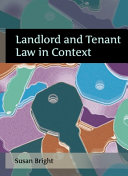
Landlord and Tenant Law in Context
By - Bright, Susan (Lawyer)
Floor
-
Floor 1
Published
-
Hart, Oxford, ©2007
ISBN 10 - 1841137227
ISBN 13 - 9781841137223
Book Status
-
2 Qnty Available with us.
Subject
-
Wales
Shelf No
-
18
Call Number
-
346.4204 BRI
Physical Description
-
lxxiv, 816 pages ; 25 cm
Notes
-
Includes Bibliographical References and Index.